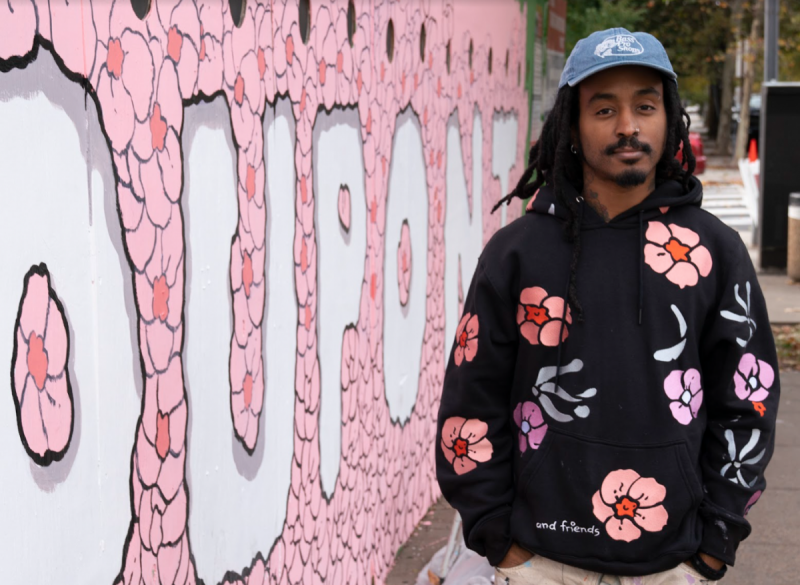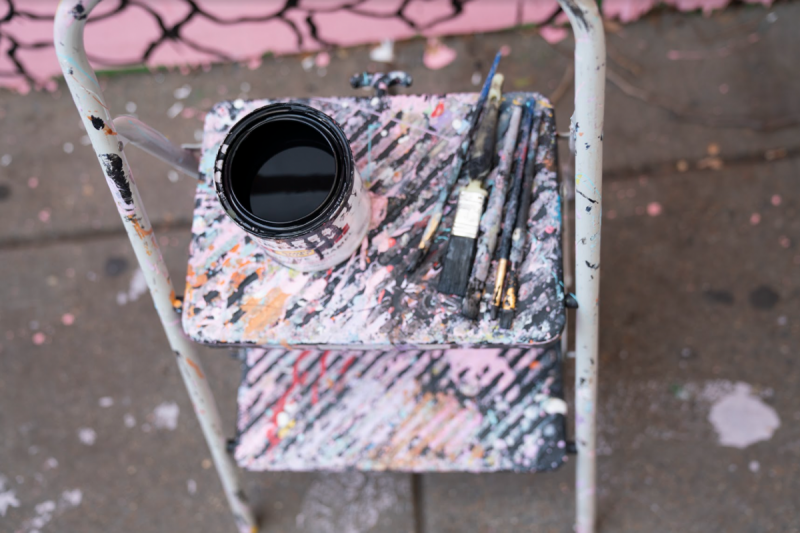DC’s Chris Pyrate brings his signature Cherry Blossom art to Dupont Circle

Chris Pyrate poses in front of his “Bloom Dupont” mural in Dupont Circle. by the author.
Riders getting off the Metro at Dupont Circle North trek up the long escalator into the light. At the top of the steps, green construction boards surround the station entrance. At one of the boards, Chris Pyrate stands on a step stool. Paint splotches cover his pants and phone case as he dots the boards with painted outlines of familiar pink flowers. The bouquet of DC’s beloved cherry blossoms are starting to take shape, outlining the word “DUPONT” in WMATA’s most recent mural project.
“I used to take the Metro as a kid,” Pyrate said. “It was my car, train, and plane. And full circle now, I get to come bless it with some art.”
The piece titled “Bloom Dupont” is part of the Art In Transit initiative by WMATA and is in collaboration with the Dupont Circle Business Improvement District (BID). The green boards-turned-canvases are part of the ongoing canopy construction project to cover the station’s escalators.
Dupont Circle Metro station. Image by the author.
“As far back as I can remember, my family has called me an artist,” Pyrate said.
Professionally, he became an artist around 2011. He was in school at the Art Institute of Washington and was working a retail job where he designed apparel. When the store closed, Pyrate took his earnings and moved to Brooklyn, a city with a more welcoming art scene at the time. He then moved to Miami, where he made his first cherry blossom mural.
“Cherry blossoms are just a big part of my work, you know coming from DC,” Pyrate said. “I’ve traveled, lived a lot of other places. So eventually, I got homesick and wanted to communicate more where I’m from through my work, and it came out in the cherry blossoms.”
Chris Pyrate works on his “Bloom Dupont” mural in Dupont Circle. Image by the author.
“When I lived in New York and Miami, these are very mature art cities,” Pyrate explained. “The cities have a long-standing relationship with art. You almost know how [the city] is gonna use art. Whether that’s graffiti, art installations, gallery shows, or murals everywhere, you almost go to a city expecting certain types of art.”
In the 1970s and early ’80s, New York artists covered subway trains with graffiti. At the time, New York was considered to be in one of its most dangerous periods, and the growth of graffiti culture became synonymous with crime.
Keith Haring, one of the multiple notable artists whose art thrived on subway walls, was arrested numerous times and charged with defacing public property. Lee Quiñones, aka “LEE” — a living legend of the 1970s graffiti wars” according to The New York Times — addressed political and cultural issues in his graffiti that spanned entire MTA subway cars.
After a major crackdown on New York’s subway graffiti in the late ’80s, the city celebrated having graffiti-free trains.
Today, patrons can buy a book featuring 31 of Haring’s subway drawings, and fans flock to his Once Upon a Time mural in a bathroom at The Center in the West Village, which features the same style he used on subway walls that turned him into a pop icon. Quiñones, a Puerto Rican-born artist, went on to collaborate on graphics for clothing brands such as Adidas and Supreme. Today, Quiñones’ work appears around the world in the Whitney Museum of American Art in New York, the Groninger Museum in the Netherlands, and the Staatliche in Berlin.
Documentary filmmaker Henry Chalfant credits photographing a subway car that “Lee” painted in 1977 in the Bronx as a turning point in his famed career. Chalfant went on to photograph what has been deemed the “definitive document of graffiti culture in New York.” In 1983, Chalfant co-produced the PBS documentary Style Wars, a later produced the book, Subway Art.
In the past few decades, the MTA Arts & Design has commissioned more than 260 art installations in stations throughout the city’s underground and has even turned entire subway cars into art installations. New York is now a cautionary tale, as structures get tagged as soon as scaffolding goes up if pieces aren’t commissioned by the city.
Pyrate says visitors to New York can tell the city’s natural aesthetic without ever stepping into a gallery, and he believes it’s just as important for DC to blossom into its own artistic identity.
A job as creative director with Pabst Blue Ribbon brought Pyrate back to DC in 2019.
When WMATA and the Dupont Circle BID reached out to him about the metro murals project, he knew exactly what he wanted to contribute to the city’s walls. In his previous floral designs, he’s done expansive flower patterns based around the cherry blossoms, using additional complementary flowers to accentuate the pink blossoms.
The goal of this project back home in DC was to keep it very simple and feature just the cherry blossom itself.
Chris Pyrate's “Bloom Dupont” mural. Image by the author.
With institutions such as the Phillips Collection and installations such as Dupont Underground, Dupont Circle isn’t the most unsurprising neighborhood for art displays in the city — and that’s intentional.
“It’s always been a safe space for people with different ideas, and to kind of push progressive ideas and new concepts forward,” said Colleen Hawkinson, Executive Director of the Dupont Circle BID. “At the BID, we really like taking that concept and seeing how that can be translated in the art world right amongst and within all of these really more traditional art spaces.”
The BID has commissioned four murals since 2019 and showcased a Cherry Blossom sculpture for the 2021 Festival. All of the artists are local artists and four of them are people of color.
“Bloom Dupont” is expected to be on display as long as the canopy project is under construction, likely until Spring 2022.



